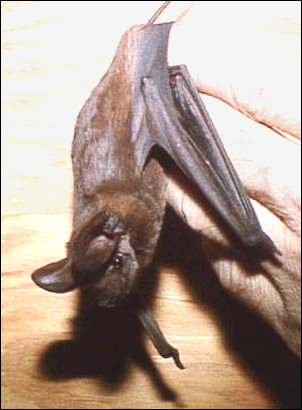


Nyctinomops macrotis. Photograph by M. Siders, Bureau of Land Management (image brightened to bring out facial area).
In Texas, these bats have been recorded from the Trans-Pecos where they inhabit rugged, rocky country in both lowland and highland areas (Schmidly, 1977). This bat is rare in collections and limited observations might indicate that these bats are migratory, heading south for the winter in the month of October and returning to Texas during the month of May (Tuttle, 2003). An additional consideration is that this bat may possibly hibernate in the Trans-Pecos (Davis and Schmidly, 1994). "With the exception of a single specimen from San Patricio County, which was found hanging on a screen door at the Welder Wildlife Refuge in December of 1959, no winter records of this species have been recorded for Texas" (Davis and Schmidly, 1994:76). In the Trans-Pecos in summer, only a few males have been taken, possibly indicating a segregation of the sexes occurs during this time (Davis and Schmidly, 1994). It is not common practice for this bat to form nursery colonies, although one is thought to exist in McKittrick Canyon in Guadalupe Mountains National Park (Davis and Schmidly, 1994).
Davis, W. B., and D. J. Schmidly. 1994. The mammals of Texas. Texas Parks and Wildlife Press, Austin.
Schmidly, D. J. 1977. The mammals of Trans-Pecos Texas including Big Bend National Park and Guadalupe Mountains National Park. Texas A&M University Press, College Station.
Tuttle, M. D. 2003. Texas bats. Bat Conservation International, Inc., Austin.
A. Ruth Huckaby, Graduate Student, BIOL 5301-Natural History of the Chihuahuan Desert, June, 2006.
Huckaby Update: 22 June 2006
Last Update: 6 Aug 2006